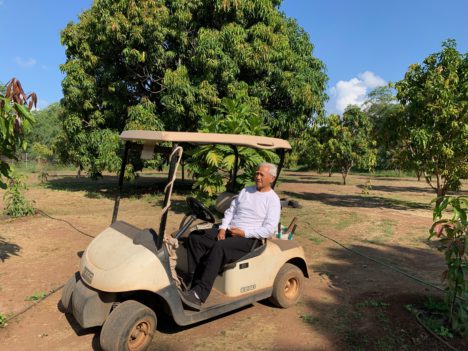From Firefighter to Farmer
By Paul Hanley, Community Reporter

Photo by Paul Hanley.
Weymouth Kamakana is 85 years old but looks 10 years younger. When he is not on dialysis—every other day for four hours—he can usually be found in his golf cart, inspecting his mango orchard in Kalamaula.
“When I was young,” says Kamakana, “I did everything, ran marathons, paddled to Oahu. I had a lot of energy. When I retired after 28 years as a firefighter, I had to find something to keep active. There were two big mango trees on our property, planted by my parents. This area is nice and hot, mangoes like plenty of heat and sun. I thought, ‘I’ll grow mangoes.’”
Today, Kamakana produces some of Molokai’s best mangoes on land settled by his parents, William and Edith Kamakana, who were among the first contingent of Hawaiian homesteaders. They grew taro and also raised cattle on the east end.
“First I cleaned out all the kiawe trees and prepared the land. I visited a nursery in Honolulu that recommended Rapoza as a cultivar to grow because it produces fruit every year—not all cultivars do. At first, we tried grafting, but you have to be pretty good at it for that to work. So now we start trees from seed,” he says.
Weymouth’s wife Julie Kamakana starts the seedlings.
“She has ‘good hands,’” says Kamakana, “She grows the seedlings and I plant them. Once in the ground they take about three more years to start producing fruit.” Julie, who operates a popular country store on their property and is well known for selling orchids and other ornamental plants, also breeds unique varieties of hibiscus.
At this point, the Kamakana’s orchard has about 60 trees. “That is enough for me to handle. If I was not disabled, I would go bigger. Whatever you pick, it is not enough, people keep coming.” Kamakana has one person helping him, one day a week. He uses the golf cart to get around but still plants the trees himself.
“When I fall,” he calmly explains, “I blow a whistle and my wife comes and helps me up.”
Mangoes were introduced to Hawaii from India and Philippines two hundred years ago, in 1824. There are more than a thousand mango cultivars. Rapoza, Kamakana’s main cultivar, is a large, high-quality mango developed by the Department of Horticulture, University of Hawaii at Manoa. Other cultivars grown by Kamakana include Haden, Pirie, Nam Dok Mai, a cultivar from Thailand, and Mapulehu which was developed on Molokai. Mapulehu is also known as “Joe Welsch,” after the man who developed the novel cultivar.
At one time, Molokai was home to the largest mango orchard in Hawaii, with the most varieties of mangoes. The former Hawaiian Sugar Planters’ Association (HSPA) Mapulehu Nursery was established on 40 acres of beachfront property. It had 2,000 trees with varieties from around the world. The HSPA discontinued active maintenance of the orchard in 1983.
“We also grow a Chinese variety that people here use to make pickle,” says Kamakana. “I am trying breadfruit too. And we have some delicious oranges.”
“We had to overcome some obstacles. We lost a lot of trees to deer and had to replant. Last year we put up a fence. We installed underground water lines and drip irrigation. It is hard work.”
Weymouth Kamakana is also a musician. For 20 years, he has played ukulele at Grace Episcopal on Sundays. He has three children. One daughter teaches at Kaunakakai school, another recently retired as a ticket agent with American Airlines, and his son is a bus driver in Honolulu.
Kamakana hopes that his son will return to Molokai and start farming a 30-acre property the family has near the airport, continuing the farming tradition into the third generation.












Don't have a Molokai Dispatch ID?
Sign up is easy. Sign up now
You must login to post a comment.
Lost Password